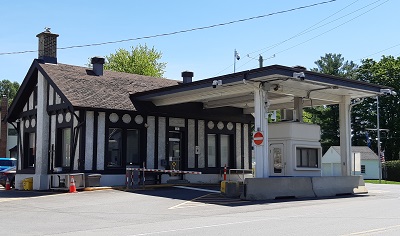Border Crossing Facility
Recognized Federal Heritage Building
Stanstead, Quebec

View of the Border Crossing Facility
© Agence des Douanes et du Revenu du Canada / Canada Customs and Revenue Agency
Address :
2 Principale Street (Highway 247), Beebe, Stanstead, Quebec
Recognition Statute:
Treasury Board Policy on Management of Real Property
Designation Date:
2001-03-15
Dates:
-
1932 to 1932
(Construction)
Event, Person, Organization:
-
Department of Public Works
(Architect)
Other Name(s):
-
Customs / Immigration Building
(Other Name)
Custodian:
Canada Customs and Revenue Agency
FHBRO Report Reference:
00-102
DFRP Number:
06353 00
Description of Historic Place
The Border Crossing Facility is located in the village of Beebe. It is a one-and-a-half storey, gable-roofed building designed in the Tudor-Revival style. Its picturesque form is embellished with gables, white stucco and half-timbering. Multi-pane wood windows are regularly arranged on the building’s façades and a brick chimney projects from the roof. A flat-roofed breezeway, which shelters the entrance, is attached to the building to protect the vehicles that pass through the border crossing. The designation is confined to the footprint of the building.
Heritage Value
The Border Crossing Facility is a Recognized Federal Heritage Building because of its historical associations, and its architectural and environmental value.
Historical Value
The Border Crossing Facility is closely associated with the federal government’s construction of customs and immigration posts along the Canada-U.S. border to control the land circulation of goods and services. The construction of this border crossing facility at Beebe was a response to the smuggling scandal of 1926, which initiated the concern to strengthen Canada’s border with the United States.
Architectural Value
The Border Crossing Facility is valued for its good aesthetic and functional design. The Canadian government chose the Tudor-Revival style with the clear intention of asserting cultural and political distinctiveness. The handsome, one-and-a-half storey building, with stucco walls and gables set off by half-timbering, is a representative example from this period and demonstrates very good craftsmanship.
Environmental Value
The Border Crossing Facility reinforces the present character of its urban landscape setting. Built in the very heart of the village, it is a well-known landmark in the region.
Sources: Geneviève Charrois, Poste frontalier, Beebe, Québec, Federal Heritage Buildings Review Office, Building Report, 00-102; Border Crossing Facility, Beebe, Québec, Heritage Character Statement, 00-102.
Character-Defining Elements
The following character-defining elements of the Border Crossing Facility should be respected.
Its good aesthetic and functional design and very good craftsmanship and materials, for example: the formal elements, which help make this small one-and-a-half storey building a good example of a Tudor-Revival border crossing, particularly its picturesque form embellished with gables and its wet-dash cladding separated by half-timbering; the materials and construction techniques used for the half-timbering, including terracotta, wet dash and wood; the concept of a breezeway to protect the vehicles.
The manner in which the Border Crossing Facility reinforces the picturesque character of urban landscape setting and is a well-known landmark, as evidenced by: its relationship with the street and the Canada-U.S. border, which it serves; its overall scale, design and materials, which complement its urban surroundings; its high visibility in the urban fabric of Beebe and its familiar role as a high traffic border crossing.
Heritage Character Statement
Disclaimer -
The heritage character statement was developed by FHBRO to explain the reasons for the designation of a federal heritage building and what it is about the building that makes it significant (the heritage character). It is a key reference document for anyone involved in planning interventions to federal heritage buildings and is used by FHBRO in their review of interventions.
Reasons for Designation
The Beebe border crossing facility is a “Recognized” Federal Heritage Building primarily because of its environmental and architectural values.
Historical value:
In the wake of the smuggling scandal of 1926, the federal government commenced construction of numerous customs and immigration posts along the Canada-U.S. border to control the land circulation of goods and persons. The construction of the Beebe border crossing facility was a product of this concern to strengthen our border with the United States.
Architectural value:
The border crossing facilities built in the late 1920s were often simple brick or wood structures fitted with canopies to protect the vehicles. Their appearance changed over the next decade, probably in response to the U.S. government’s decision to build imposing brick edifices, usually in the colonial Georgian style, at the main border posts. With the clear intention of asserting its cultural and political distinctiveness, the Canadian government chose the neo-Tudor style. The Beebe border crossing facility, a one-and-a-half storey building whose stucco walls and gables are set off by half-timbering, is a representative example from this period.
Environmental value:
Built in the very heart of the village, the Beebe border crossing facility is not only one of the most important components of the urban landscape, but also one of the handsomest in terms of its aesthetics. It receives most cross-border traffic in the region by far.
Character-Defining Elements
The following character-defining elements of the Beebe border crossing facility should be respected:
· The formal elements which help make this small one-and-a-half storey building a good example of a neo-Tudor border crossing, particularly its picturesque form embellished with gables and its wet-dash cladding separated by half-timbering;
· The materials and construction techniques used for the half-timbering (terracotta, wet dash and wood);
· The concept of a breezeway to protect the vehicles;
· The relationship of this border crossing facility with the street and the Canada-U.S. border which it serves;
· Its formative value and high visibility in the urban fabric of Beebe.